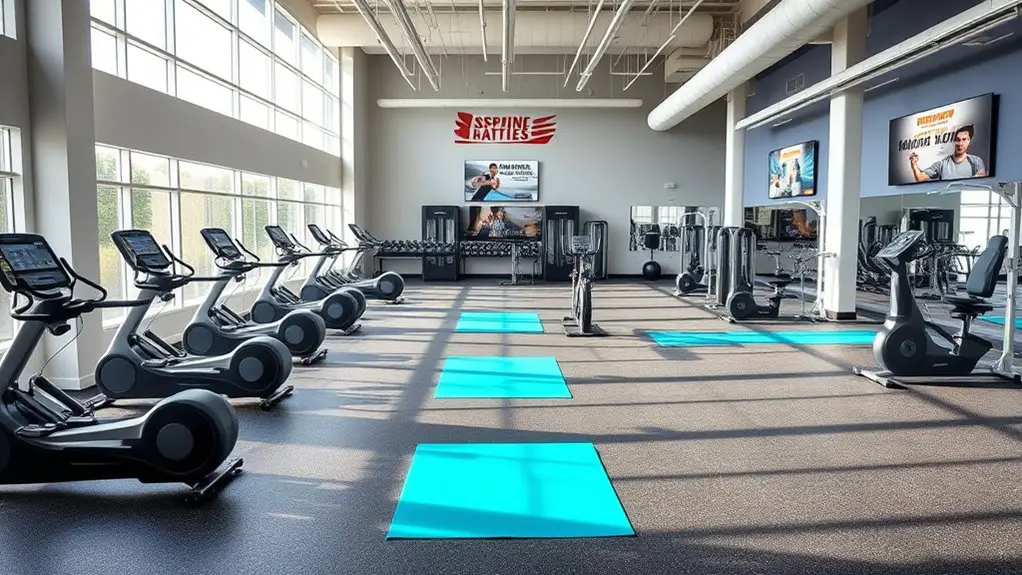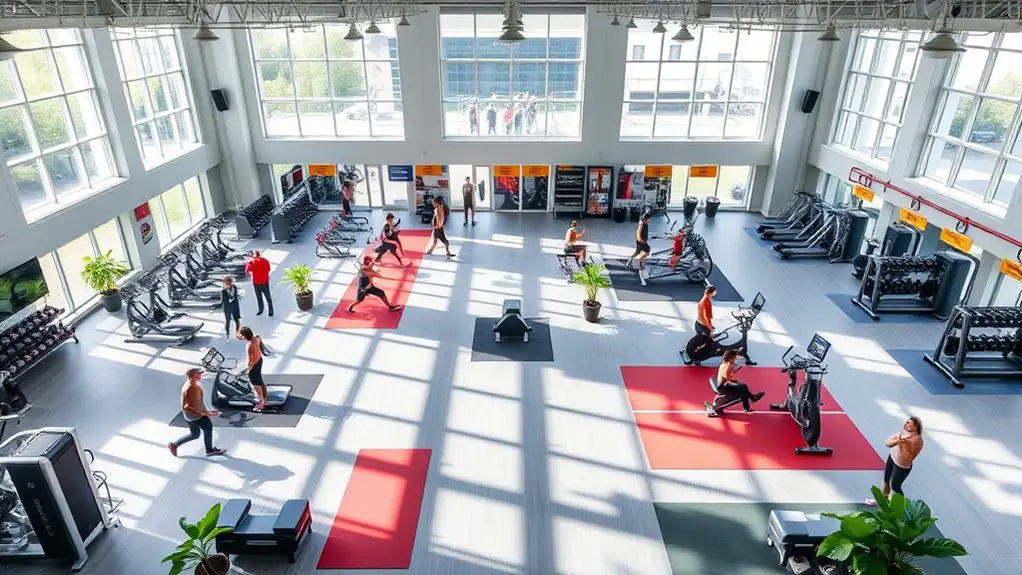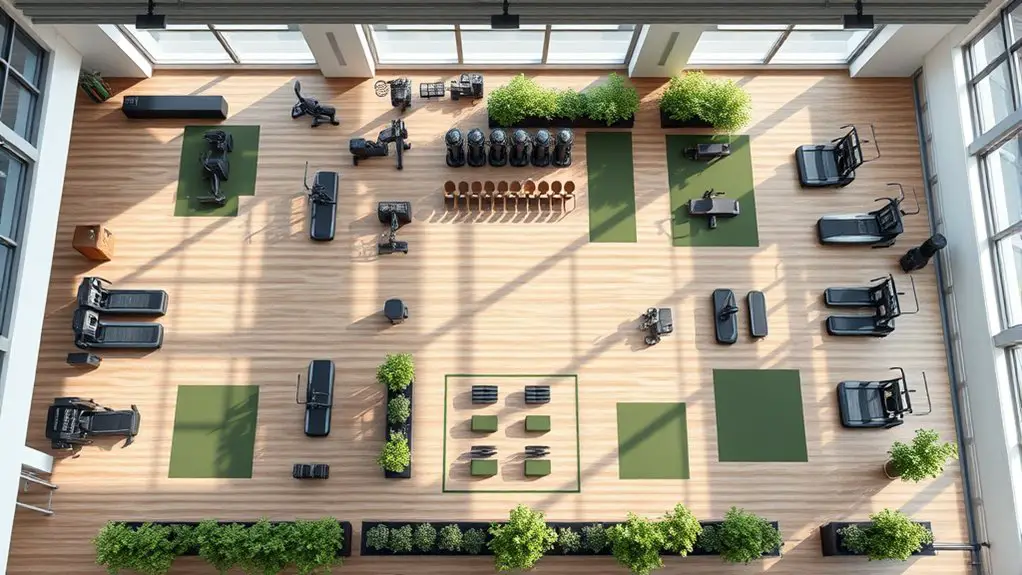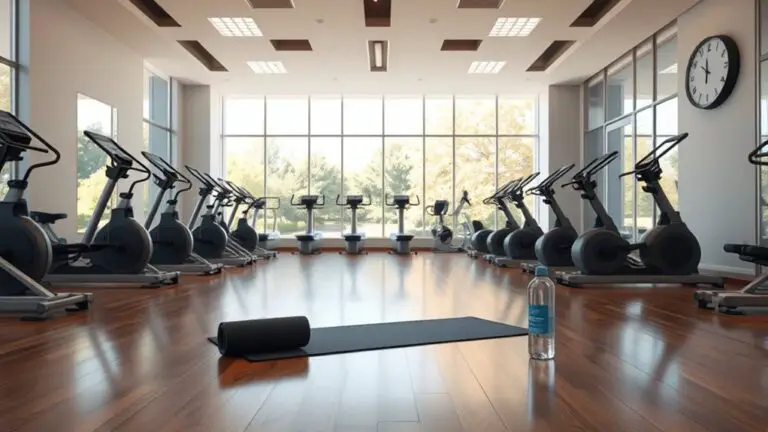How to Design a Gym Floor Plan for Maximum Efficiency

To design a gym floor plan for maximum efficiency, start by analyzing your members’ demographics and needs. Create functional zones for specific activities, like cardio and weightlifting. Optimize equipment placement with at least three feet between machines, and position popular gear at the front. Guarantee clear pathways for smooth traffic flow, minimizing congestion. Finally, incorporate flexible spaces for future growth. With these strategies, you’ll enhance user experience and promote effective workouts—there’s more to explore for an even better layout.
Assessing Your Space and Member Needs

How do you determine the right layout for your gym? Start by analyzing your member demographics. Are they mainly young professionals, families, or seniors? Understanding who your members are helps you tailor the design to fit their specific needs. Next, consider space limitations. You might have a small footprint, but that doesn’t mean you can’t optimize functionality. Create a balance between cardio machines, strength training areas, and open spaces for group activities.
Think strategically about traffic flow—ensure that high-traffic zones don’t create bottlenecks. Additionally, consider incorporating multi-functional equipment to maximize usage within limited space. Prioritize visibility and accessibility, making sure all areas are easy to navigate. By aligning your gym layout with member needs and working within space constraints, you’ll create an inviting environment that encourages regular visits and fosters a sense of community.
Establishing Functional Zones
While designing your gym floor plan, establishing functional zones is essential for maximizing efficiency and enhancing user experience. Begin by creating clear functional area definitions that categorize space based on user activity, such as weightlifting, cardio, group classes, and stretching. This segmentation helps in devising activity specific zones tailored to different fitness goals and preferences, guaranteeing that members can navigate the space easily.
Consider the flow of movement when placing these zones; placing high-intensity areas near quieter zones minimizes distractions and enhances focus. Integrating flexibility within these zones allows for adaptive use, accommodating various classes or personal training sessions. Additionally, verify that each zone is equipped with the necessary amenities and equipment, promoting a seamless changeover between activities. By strategically establishing functional zones, you not only optimize space utilization but also create a dynamic and inviting environment that encourages members to engage fully in their fitness journeys. Moreover, mixing up routines can combat boredom in workouts, ensuring that members stay motivated and enjoy their time at the gym.
Optimizing Equipment Placement

With functional zones established, the next step is to focus on optimizing equipment placement to enhance accessibility and usability. Start by considering equipment spacing; you want to guarantee that each piece is easily reachable while avoiding overcrowding. A good rule of thumb is to maintain at least three feet of space between cardio machines and strength equipment, allowing for a comfortable flow of movement.
Incorporate accessibility considerations by placing frequently used machines at the front of the gym and guaranteeing that all equipment is within easy reach for members of varying fitness levels. You might also want to group similar pieces together, such as placing free weights near benches and resistance machines, to create a cohesive workout experience.
Ensuring Efficient Traffic Flow
To guarantee efficient traffic flow in your gym, it’s crucial to design pathways that minimize congestion and enhance the user experience. Understanding traffic patterns will help you optimize space utilization and guarantee seamless movement throughout the facility. Here are three key strategies to reflect on:
Effective gym design focuses on optimizing traffic flow with clear pathways, enhancing user experience and minimizing congestion.
- Zoning: Divide your gym into specific areas, like cardio, strength training, and functional fitness, to direct traffic and reduce bottlenecks.
- Clear Signage: Use signs to guide members to different zones, equipment, and exits, making navigation intuitive and efficient.
- Wide Pathways: Confirm pathways between equipment are spacious enough to accommodate multiple users, allowing for smooth shifts and avoiding collisions.
Incorporating Flexibility for Future Growth

As gym trends evolve and member needs change, incorporating flexibility into your floor plan becomes essential for accommodating future growth. You’ll want adaptable spaces that can easily shift between various uses, whether it’s group classes, personal training sessions, or open gym areas.
Consider the following table to visualize potential configurations for your gym:
| Space Type | Adaptability Opportunities | Ideal Future Trends |
|---|---|---|
| Group Class Area | Movable partitions for versatility | High-Intensity Classes |
| Weight Training | Adjustable equipment layout | Functional Training |
| Cardio Zone | Flexible equipment placements | Virtual Fitness |
| Open Space | Multi-use for events and classes | Wellness Workshops |
Frequently Asked Questions
What Should I Consider for Parking and Accessibility?
Imagine your gym’s parking lot bustling like a 1950s diner! For effective parking layout, guarantee spaces are clearly marked and organized, allowing for smooth traffic flow. Consider adding accessibility features like designated spots for those with disabilities, ramps, and wide pathways to the entrance. Think about the overall layout; it should accommodate both regular visitors and those needing extra assistance, creating an inviting and functional environment for everyone.
How Can I Incorporate Natural Light Into My Design?
To incorporate natural light into your design, focus on strategic window placement. Consider large, floor-to-ceiling windows on the south-facing wall to maximize sunlight during the day. You’ll enjoy the natural light benefits, such as improved mood and energy levels for gym-goers. Additionally, using skylights can further enhance brightness in interior spaces. Balancing natural light with artificial lighting guarantees an inviting atmosphere while promoting a healthy, vibrant environment for your clients.
What Colors Promote Motivation and Energy in a Gym?
When choosing colors for your gym, consider color psychology. Energizing hues like bright reds, vibrant oranges, and lively yellows can greatly boost motivation and energy levels. These colors stimulate the mind and body, creating an atmosphere that encourages activity. Balance them with cooler shades for rest areas to guarantee a harmonious environment. By strategically using these colors, you’ll create an engaging space that inspires your clients to push their limits and stay committed.
How Do I Select Flooring Materials for Safety and Comfort?
Did you know that 67% of gym injuries are related to flooring? When selecting flooring materials, you need to prioritize safety standards and comfort levels. Look for surfaces with non-slip textures and adequate shock absorption to minimize injury risk. Rubber flooring is a popular choice, as it balances durability with comfort. Additionally, consider the maintenance requirements and aesthetics to create an inviting atmosphere that encourages members to stay active and engaged.
What Technology Can Enhance Member Experience in My Gym?
To enhance your gym’s member experience, consider integrating fitness apps and virtual classes. These technologies can provide convenient scheduling, personalized workouts, and real-time progress tracking. By offering virtual classes, you can reach members who prefer exercising at home, while fitness apps can encourage engagement through challenges and community features. It’s a strategic way to cater to diverse preferences, ensuring your members feel connected and motivated, whether they’re in the gym or at home.





